
CENTRAL BANKERS IN A BOX
February 7, 2015
The environment in the
global financial markets continues to grow more interesting as it deals
with extreme monetary policies, deflationary pressures in the real
economy and the competition for global trade in the midst of overall
muted growth. This month
let’s take a look at the increasing challenges the Federal Reserve is
facing and a few new bizarre developments in the financial markets.
First, let’s see how
this brilliant central bank of ours continues to box themselves into a
more challenging position.
Over the past five years they have kept interest rates at zero and have
printed trillions of dollars and the rest of the world central banks
have followed their strategy at an increasing pace.
This month I won’t go into all the reasons why they never should
have printed all this money or cut rates to zero, much less why they
should have raised rates earlier.
So, the unemployment
rate stands at 5.7% and job growth from the government numbers was
pretty strong in January.
Wage growth was much better as well.
The Fed is starting to feel pressure from some of the economic
numbers in the U.S. to move rates higher since most would think that
zero interest rates is more indicative of an environment like the
financial panic in 2008. As
a result, many are forecasting that the Fed will begin to raise rates
starting in June. Since the
Fed tends to rely more on coincident economic data points like the
monthly payroll numbers rather than leading indicators, more Fed members
have recently confirmed that a rate hike is likely to come mid-year.
It is our central bank
that started the competitive devaluation game that is being played
around the world. Since
global growth is slow and may be slowing, countries are increasingly
trying to devalue their currency to make their goods cheaper and capture
more global trade. The
European Central Bank recently announced that they are going to print a
trillion dollars over the next year, smaller developing countries are
cutting rates and it even looks like China may start targeting their
currency more aggressively as they are struggling with slowing growth.
While many countries
around the world are following our lead and moving more forcefully
toward devaluing their currency, our Fed is now facing pressure to raise
rates and this has been reflected in the rapid rise in the U.S. dollar.
Here is a chart to illustrate the rise.
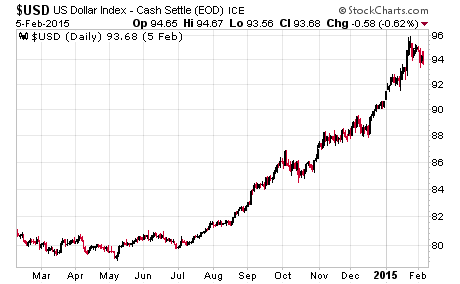
Just in the last seven
months, our currency has risen by over 20%.
Now, what do you think we are likely to hear from our companies
in the U.S. who are competing for global trade?
This earnings season we have heard more and more companies
talking about the challenges they are facing from the rising dollar.
We are likely to start hearing more opposition to the Fed’s plan
to begin raising rates from more of our corporate leaders.
CENTRAL BANKERS IN THE ROACH
MOTEL…
Just in the last week,
two high profile leaders in the corporate world have voiced their
opinions on this; Jack Welch, former CEO of GE, and Warren Buffett.
Welch was interviewed this week on CNBC and said, “The Federal
Reserve would be crazy to increase interest rates in the near future.
It would be insane.
Your exports would fall off the table even more.”
Then, Warren Buffett
chimed in as reported in an article by CNBC.
“With the rise of new international conflicts and foreign
countries diluting their currencies, Warren Buffett said it would not be
feasible for the Federal Reserve to increase rates.
‘If Europe's got them at zero, and you get higher rates in the
United States, that would exacerbate a problem with the stronger dollar
and funds flow,’ the Oracle of Omaha said on Wednesday.”
This week the U.S.
trade balance for December was released.
Our trade deficit was much higher than expectations and soared
17.1%. This will cause
notable downward revisions to 4th quarter GDP.
Corporate America will increasingly apply pressure to the Federal
Reserve not to raise rates due to the currency impact.
Once you start down this game of competitive devaluations, it
becomes more and more challenging to exit the game.
It is the roach motel of monetary policy.
So, on the one hand,
you have Welch and Buffett leading the charge from corporations warning
the Fed they had better not raise rates due to the currency issues, and
then on the other hand, you have economists jumping up and down over the
“wonderful” January employment report and claiming that the Fed better
start now in raising rates or they are going to get behind the curve.
Let’s dive a little deeper to see if the economists have much of
a case relating to the job gains and wage increases in January.
WHAT A FANTASTIC JOB MARKET…
First, let’s take a
look at an article by Jim Clifton, CEO of Gallup.
“Here's something that many Americans -- including some of the
smartest and most educated among us -- don't know: The official
unemployment rate, as reported by the U.S. Department of Labor, is
extremely misleading. Right
now, we're hearing much celebrating from the media, the White House and
Wall Street about how unemployment is ‘down’ to 5.6%.
The cheerleading for this number is deafening.
The media loves a comeback story, the White House wants to score
political points and Wall Street would like you to stay in the market.”
“None of them will tell
you this: If you, a family member or anyone is unemployed and has
subsequently given up on finding a job -- if you are so hopelessly out
of work that you've stopped looking over the past four weeks -- the
Department of Labor doesn't count you as unemployed.
That's right.
While you are as unemployed as
one can possibly be, and tragically may never find work again, you are
not counted in the figure we see relentlessly in the news -- currently
5.6%. Right now, as many as 30
million Americans are either out of work or severely underemployed.
Trust me, the vast majority of
them aren't throwing parties to toast ‘falling’ unemployment.”
“There's another reason
why the official rate is misleading. Say
you're an out-of-work engineer or healthcare worker or construction
worker or retail manager: If you perform a minimum of one hour of work
in a week and are paid at least $20 -- maybe someone pays you to mow
their lawn -- you're not officially counted as unemployed in the
much-reported 5.6%. Few
Americans know this.”
“Yet another figure of
importance that doesn't get much press: those working part time but
wanting full-time work. If you
have a degree in chemistry or math and are working 10 hours part time
because it is all you can find -- in other words, you are severely
underemployed -- the government doesn't count you in the 5.6%.
Few Americans know this.”
In a follow up
interview, Clifton said, “The number of full-time jobs, and that’s what
everybody wants, as a percent of the population, is the lowest it’s ever
been…The other thing that is very misleading about that number is the
more people that drop out, the better the number gets.
In the recession we lost 13 million jobs.
Only 3 million have come back.
You don’t see that in the number.”
MINIMUM WAGE AND UNEMPLOYMENT
BENEFITS SKEW DATA…
So, Clifton addresses
the quality of the government jobs data.
Now, let’s see what ECRI [Economic Cycle Research Institute]
noted about the actual job and wage gains.
“Certainly, yoy [year-over-year] growth in the number of people
with a single job has been trending up over the past year or so.
But the real surge was in yoy
job growth for multiple jobholders, which remains near October’s 18-year
high, accounting for a disproportionate share of the past year’s job
gains, following the termination of extended unemployment benefits at
the end of 2013.”
ECRI highlights that at
the end of 2013, extended unemployment benefits were terminated.
“Surprisingly”, job gains as noted by the government picked up.
As people are cut off from payments from the government, they
have more incentive to find something out there to earn some money.
Remember that if you work at least one hour a week and get paid
at least $20 you are not counted as unemployed, since you found a “job”.
Also, ECRI notes that much of the jobs gains came from multiple
job holders. This indicates
that the type of jobs that are being created are part-time or low
quality since many are having to find multiple sources of work to
support themselves.
If we look back at
December, wage growth was negative.
Subsequently, we saw wage gains in January which the economists
were excited about since it gave them some hope regarding the
deflationary pressures.
ECRI sheds some light over the wage gains this past month.
They noted that the boost in January coincided with a rise in the
minimum wage in many states.
That indicates that the wage gains did not come from market
forces and any gains in the near-term may be dependent on other states
joining the minimum wage increases.
That is not the type of wage gains that suggest healthy economic
growth or relief from deflationary pressures.
A DEEPER ISSUE…
Next, let’s take a look
at what may be more of a structural challenge for the economy as we move
forward. An article by
Steve Goldstein, at MarketWatch, noted that the Labor Department tracked
productivity growth in the economy at -1.8% for the 4th
quarter of last year and that productivity grew only 0.8% for the year.
Also, since the last recession, productivity has not increased by
more than 1% in any year. This is partly a reflection of the weak
capital investment by corporations.
Goldstein notes that a
quick estimate of growth potential for the U.S. economy is the sum of
productivity growth plus the growth in the working-age population.
The working age population is expected to decline from 0.5%
currently to 0.2% in 10-years’ time.
In 2000, the last year that the economy grew over 4%, the
working-age population grew 2.1%.
The muted productivity and working-age population growth is shown
in the chart below.
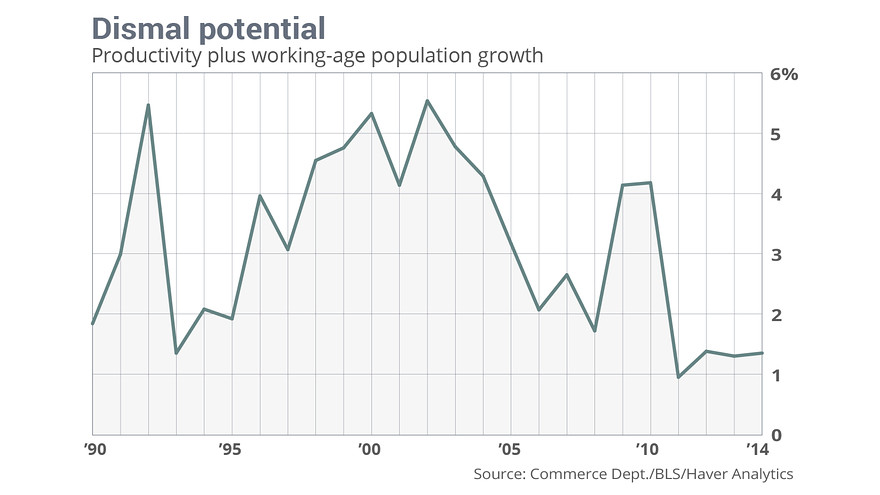
The anemic economic
growth that we have seen since 2008 is likely to continue.
This is further evidence of how Fed policy has been ineffective
in helping the real economy.
LEADING INDICATORS ARE
SLOWING…
It is also worth
highlighting ECRI’s leading indicator for economic growth in the U.S.
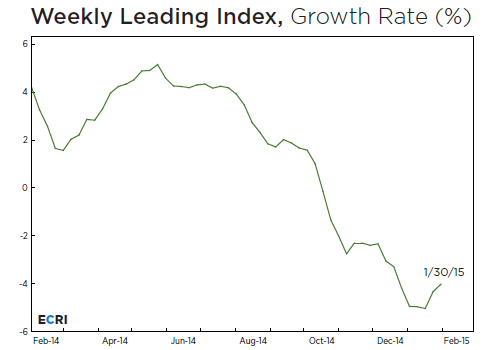
Their weekly leading
indicator suggests that growth may actually slow in the U.S. in the
coming months and recouple with the weakness that is going on in most
areas of the world economy.
All of this likely
suggests that the Fed will not end up raising rates in June, or if they
do, they will find that the market starts to price in a policy mistake
due to the realization of a slowing economy and increasing pressure on
trade from the rising dollar.
THE BIZZARRO WORLD…
Before I close, let’s
highlight a few of the growing bizarre developments in the world of
finance around the globe.
-
German 10-year bund yields have now dropped
below 10-year Japanese Government bond yields – wasn’t the worst of
deflationary pressures in Japan?
-
Following 3 consecutive rate cuts by the Danish
Central bank, BBC News reported that a local bank offered a mortgage
with a negative interest rate!
In effect, with negative interest rates, you could have savers
pay the bank to hold their money and the bank pays the debtor to take
out a loan!
-
Noted by CNN Money, chocolate is the new
gold…the yield on Nestlé’s corporate debt went negative this week.
That means that investors are willing to pay Nestle for the right
to park their money in the safety of the Swiss chocolate company!
The Euro denominated bonds of Bank of America, GE and McDonald’s
are all near zero.
-
In the same article by CNN Money, it highlights
that the central bank moves have knocked the yields on various
government bonds into negative territory including Belgium,
Denmark, France, Germany, Japan and the Netherlands.
Investors are guaranteed to lose
money on the bonds if they hold them to maturity.
And, these bonds have been the fastest growing asset class in
Europe with the total amount of euro government debt and bills yielding
below zero has surged to 1.2 trillion euros from 500 billion in October
and zero in June!
-
Here is the mentality of an institutional bond
trader in Europe – “You've got over 1 trillion of euros that will be
created. All of that new money
needs to find a home," said Thomas Urano, a managing director at
fixed-income manager Sage Advisory. "I could park it in the bank and
lose money for certain or I could put it into a corporate bond and maybe
only lose one basis point."
Amazing!
Even though global
central banks have printed over $11 trillion dollars in the past 5 years
we are sliding, in a number of areas around the world, to where savers
have to pay banks to hold their money and in some cases, the bank pays
the borrower to take out a loan.
PUTTING THINGS INTO
PERSPECTIVE…
To highlight the
backdrop of this emerging world of bizarre finance, we can look at the
following three charts.
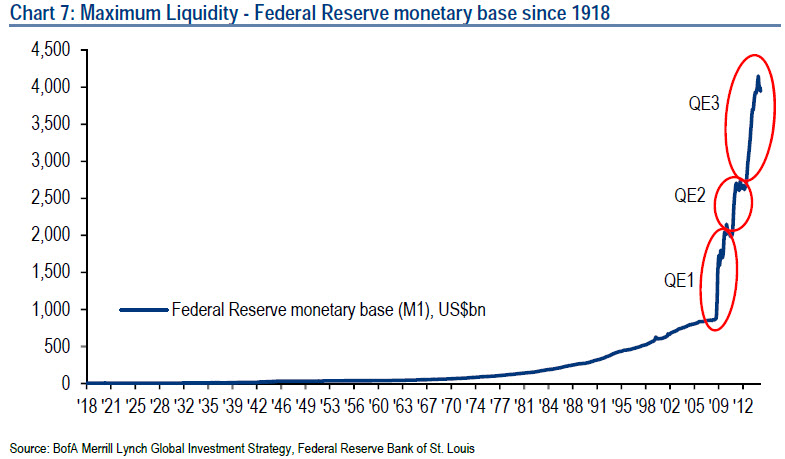
The chart above shows
our Central Bank’s monetary base.
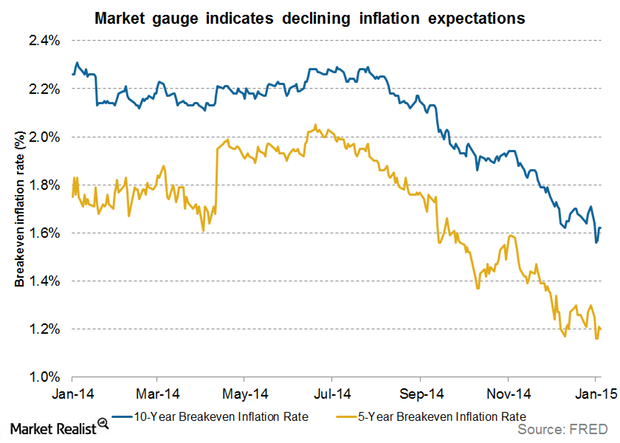
The chart above shows
market based inflation expectations even with all the free money.
Now, let’s put this
into further historical context with the following chart.
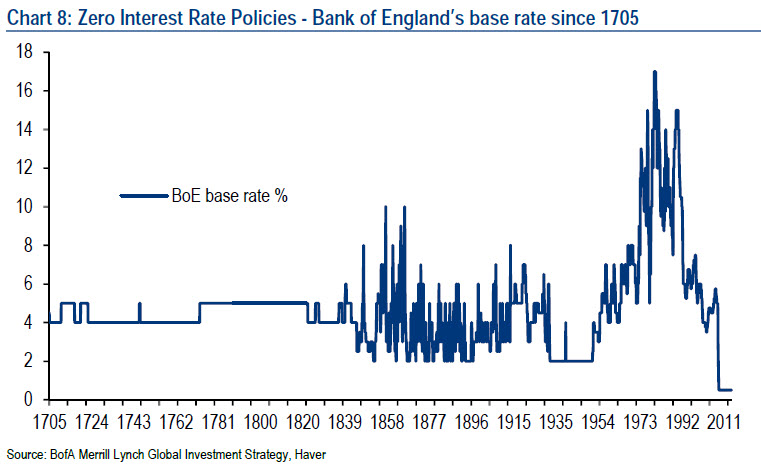
The chart above shows
the interest rate policy set by the Bank of England going back to 1705,
covering over 300 years. As
the chart illustrates, they have never been as low as they are
now...how’s that for perspective!
WHAT IF RATES GO NEGATIVE
HERE???
We are likely to see an
increasing number of oddities in the financial world as the global
economic and central bank environment evolves.
It would be interesting to see what kinds of behavior would occur
if rates were to go negative here in the U.S. like they are in parts of
Europe now. Here is a
long-term chart of short-term Treasury-bill yields from an article by
Kenneth Garbade and Jamie McAndrews of the NY Fed back in August of
2012.
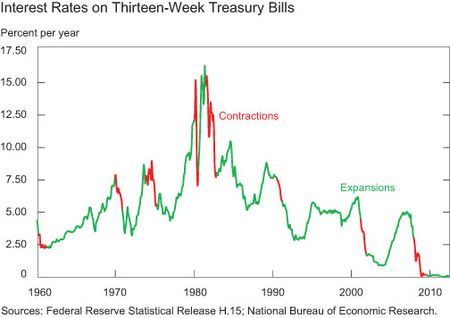
Rates are at the floor
so the next step is into negative territory if the deflation in Europe
and Japan continues to come onto our shores.
As an additional read, I have posted the article at the end of
this commentary by those two at the NY Fed contemplating the strange and
possible behaviors that they believe may occur in a negative rate
environment.
While the volatility
has increased in the stock market over the past two months, there seems
to be little concern among investors.
In fact, the latest Bloomberg poll finds investors to be the most
bullish they have been in five years.
However, it would be unusual to see the type of volatile
movements in the currency, commodity and interest rate markets like we
have seen over the past number of months without it spilling over into
the broader equity markets.
We continue to live in historical times relating to the financial
markets and I think the types of oddities that are beginning to surface,
which I highlighted above, are just getting started.
Take a look at the commentary below from the two at the NY Fed to
get your imagination going.
Some of it may seem far-fetched but a number of countries are already
going to negative rates and that seemed far-fetched not too long ago.
Joseph R. Gregory, Jr.
If Interest Rates Go
Negative . . . Or, Be Careful What You Wish For
By Kenneth Garbade and
Jamie McAndrews. August,
2012.
The United States has
slid into eight recessions in the last fifty years.
Each time, the Federal Reserve sought to revive economic activity
by reducing interest rates.
However, since the end of the last recession in June 2009, the economy
has continued to sputter even though short-term rates have remained near
zero. The weak recovery has
led some commentators to suggest that the Fed should push short-term
rates even lower—below zero—so that borrowers receive, and creditors
pay, interest.
One way to push
short-term rates negative would be to charge interest on excess bank
reserves. The interest rate
paid by the Fed on excess reserves, the so-called IOER, is a benchmark
for a wide variety of short-term rates, including rates on Treasury
bills, commercial paper, and interbank loans.
If the Fed pushes the IOER below zero, other rates are likely to
follow.
Without taking a
position on either the merits of negative interest rates or the Fed's
statutory authority to fix the IOER below zero, this post examines some
of the possible consequences. We
suggest that significantly negative rates—that is, rates below -50 basis
points—may spawn a variety of financial innovations, such as
special-purpose banks and the use of certified bank checks in
large-value transactions, and novel preferences, such as a preference
for making early and/or excess payments to creditworthy counterparties
and a preference for receiving payments in forms that facilitate
deferred collection. Such
responses should be expected in a market-based economy but may
nevertheless present new problems for financial service providers (when
their products and services are used in ways not previously anticipated)
and for regulators (if novel private sector behavior leads to new types
of systemic risk).
Cash and Cash-like
Products:
The usual rejoinder to
a proposal for negative interest rates is that negative rates are
impossible; market participants will simply choose to hold cash.
But cash is not a realistic
alternative for corporations and state and local governments, or for
wealthy individuals. The largest
denomination bill available today is the $100 bill.
It would take ten thousand such
bills to make $1 million. Ten
thousand bills take up a lot of space, are costly to transport, and
present significant security problems. Nevertheless,
if rates go negative, the U.S. Treasury Department’s Bureau of Engraving
and Printing will likely be called upon to print a lot more currency as
individuals and small businesses substitute cash for at least some of
their bank balances.
If rates go negative,
we should also expect to see financial innovations that emulate cash in
more convenient forms. One
obvious candidate is a special-purpose bank that offers conventional
checking accounts (for a fee) and pledges to hold no asset other than
cash (which it immobilizes in a very large vault).
Checks written on accounts in a
special-purpose bank would be tantamount to negotiable warehouse
receipts on the bank’s cash. Special-purpose
banks would probably not be viable for small accounts or if interest
rates are only slightly below zero, say -25 or -50 basis points (because
break-even account fees are likely to be larger), but might start to
become attractive if rates go much lower.
Early Payments, Excess
Payments, and Deferred Collections:
Beyond cash and
special-purpose banks, a variety of interest-avoidance strategies might
emerge in connection with payments and collections.
For example, a taxpayer might
choose to make large excess payments on her quarterly estimated federal
income tax filings, with the idea of recovering the excess payments the
following April. Similarly, a
credit card holder might choose to make a large advance payment and then
run down his balance with subsequent expenditures, reversing the usual
practice of making purchases first and payments later.
We might also see some
relatively simple avoidance strategies in connection with conventional
payments. If I receive a check
from the federal government, or some other creditworthy enterprise, I
might choose to put the check in a drawer for a few months rather than
deposit it in a bank (which charges interest).
In fact, I might even go to my
bank and withdraw funds in the form of a certified check made payable to
myself, and then put that check in a drawer.
Certified checks, which
are liabilities of the certifying banks rather than individual
depositors, might become a popular means of payment, as well as an
attractive store of value, because they can be made payable to order and
can be endorsed to subsequent payees. Commercial
banks might find their liabilities shifting from deposits (on which they
charge interest) to certified checks outstanding (where assessing
interest charges could be more challenging).
If bank liabilities shifted from
deposits to certified checks to a significant degree, banks might be
less willing to extend loans, because certified checks are likely to be
less stable than deposits as a source of funding.
As interest rates go
more negative, market participants will have increasing incentives to
make payments quickly and to receive payments in forms that can be
collected slowly. This is
exactly the opposite of what happened when short-term interest rates
skyrocketed in the late 1970s: people then wanted to delay making
payments as long as possible and to collect payments as quickly as
possible. Some corporations
chose to write checks on remote banks (to delay collection as long as
possible), and consumers learned to cash checks quickly, even if that
meant more trips to the bank, and to demand direct deposits.
However, if interest rates go
negative, the incentives reverse: people receiving payments will prefer
checks (which can be held back from collection) to electronic transfers.
Such a reversal could impose
novel burdens on payment systems that have evolved in an environment of
positive interest rates.
Conclusion:
The take-away from this
post is that if interest rates go negative, we may see an epochal
outburst of socially unproductive—even if individually
beneficial—financial innovation. Financial
service providers are likely to find their products and services being
used in volumes and ways not previously anticipated, and regulators may
find that private sector responses to negative interest rates have
spawned new risks that are not fully priced by market participants.